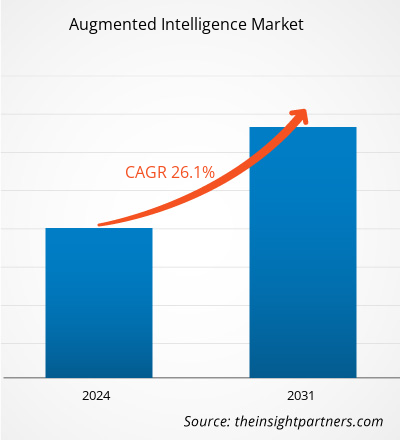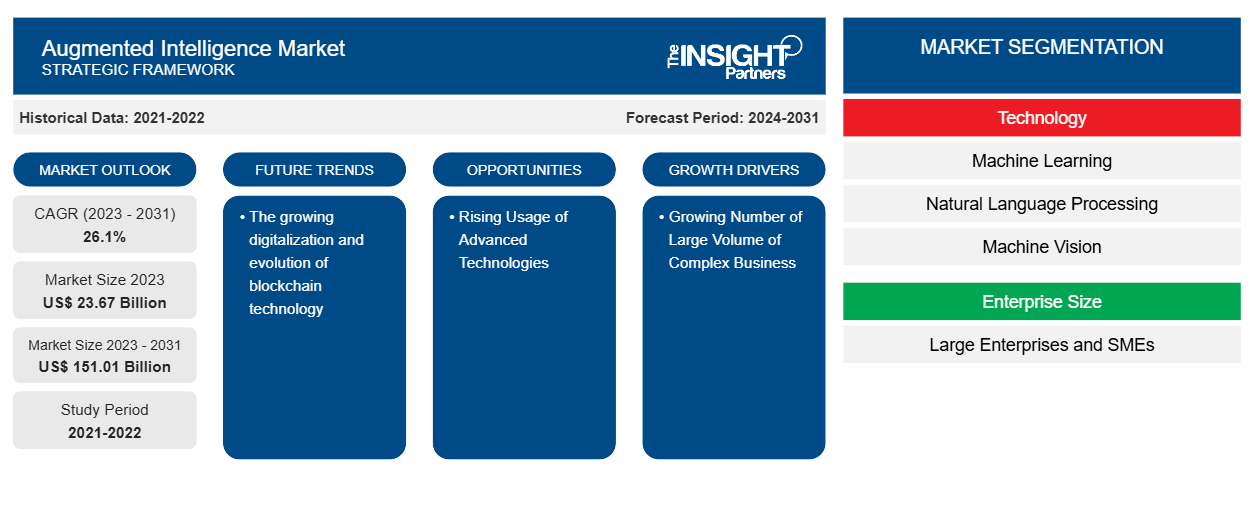拡張インテリジェンス市場規模は、2023年の236億7,000万米ドルから2031年には1,510億1,000万米ドルに達すると予測されています。市場は2023年から2031年にかけて26.1%のCAGRを記録すると予想されています。デジタル化の進展とブロックチェーン技術の進化は、拡張インテリジェンス市場の重要なトレンドであり続けると思われます。
拡張知能市場分析
拡張インテリジェンス市場は、大量の複雑なビジネス データの増加と、BFSI、IT および通信、小売および電子商取引業界の拡大により、急速に成長しています。市場は、中小企業における拡張インテリジェンスの採用の増加に牽引されて着実に拡大しています。さらに、企業における高度なテクノロジーの使用の増加とクラウドベースのソリューションの採用の増加は、市場の成長にとって有利な機会を提供しています。
拡張知能市場の概要
拡張インテリジェンスは、AI の補助機能に重点を置いた人工知能の一種です。さらに、拡張インテリジェンスは、組織がビジネスや日常生活でより正確なデータ主導の意思決定を行えるようにサポートするために作成されています。さらに、拡張インテリジェンスは、企業が従業員のパフォーマンスを向上させるために使用され、組織が従業員の改善領域を理解するのに役立ち、市場を牽引しています。さらに、拡張インテリジェンスは、企業に予測分析を提供することで、大量のセキュリティ データを使用して優先順位を付ける最も効果的な手法です。
要件に合わせてレポートをカスタマイズする
このレポートの一部、国レベルの分析、Excelデータパックなど、あらゆるレポートを無料でカスタマイズできます。また、スタートアップや大学向けのお得なオファーや割引もご利用いただけます。
- このレポートの主要な市場動向を入手してください。この無料サンプルには、市場動向から見積もりや予測に至るまでのデータ分析が含まれます。
拡張知能市場の推進要因と機会
大量の複雑なビジネスデータの増加が市場を牽引
機械学習や自然言語処理などの拡張インテリジェンス技術は、データ分析においてますます重要になっています。拡張インテリジェンスにより、企業内に保存されている組織化されたデータ ソース、半構造化データ ソース、非構造化データ ソースの分析が可能になります。今後数年間、業界の拡大や企業運営全体にわたるデジタル テクノロジーの進化に伴い、作成されるデータの多様性と量が大幅に増加すると予測されています。これにより、大量のデータを効果的かつ効率的に管理するための拡張インテリジェンス ソリューションに対する企業の需要が高まります。ただし、予測期間中、複雑なデータの量の増加により、拡張インテリジェンス市場が活性化すると予測されています。
先進技術の利用増加 – 拡張知能市場におけるチャンス
人工知能、機械学習、自然言語処理技術などの高度な技術の使用の増加により、予測期間中に市場成長の機会が生まれています。ITおよび通信、小売および電子商取引、BFSI、ヘルスケアなどの多くの業界では、膨大な量のデータが生成されており、このデータをリアルタイムで分析するための高度な技術が必要であり、拡張インテリジェンスソリューションの需要が高まっています。業界では、リアルタイムで効果的な意思決定を行うことで膨大なデータを分析するために、人工知能、機械学習、自然言語処理などの新しい技術を採用しています。これらのツールにより、データから洞察を抽出するプロセスが簡素化され、その採用が増加し、市場に機会が生まれています。
拡張知能市場レポートのセグメンテーション分析
拡張インテリジェンス市場分析の導出に貢献した主なセグメントは、テクノロジー、企業規模、エンドユーザーである。
- 技術に基づいて、拡張インテリジェンス市場は、機械学習、自然言語処理、マシンビジョン、コンテキスト認識コンピューティングなどに分かれています。機械学習セグメントは、2023年に大きな市場シェアを占めました。
- 企業規模別に見ると、市場は大企業と中小企業に分かれており、2023年には中小企業セグメントがより大きな市場シェアを占めました。
- エンドユーザーの観点から見ると、市場はITおよび通信、小売および電子商取引、BFSI、ヘルスケア、その他に分類されています。BFSIセグメントは2023年に大きな市場シェアを占めました。
地域別拡張知能市場シェア分析
拡張インテリジェンス市場レポートの地理的範囲は、主に北米、アジア太平洋、ヨーロッパ、中東およびアフリカ、南米/中南米の 5 つの地域に分かれています。
収益面では、北米が、IBM Corporation、Microsoft Corporation、TIBCO Software Inc.、Salesforce.com、Inc.、MicroStrategy Incorporatedなどの技術の進歩と主要企業の存在により、拡張インテリジェンス市場で最大のシェアを占めています。これらの企業は、AI、ML、NLPなどの高度な技術の採用に多額の投資を行っており、追加機能を追加することでこれらの技術の開発に継続的に取り組んでいます。ITおよび通信、BFSI、小売および電子商取引、ヘルスケアなどの業界におけるクラウドベースの拡張インテリジェンスの需要の高まりにより、北米の市場が拡大すると予測されています。
拡張知能市場の地域別インサイト
予測期間を通じて拡張インテリジェンス市場に影響を与える地域的な傾向と要因は、Insight Partners のアナリストによって徹底的に説明されています。このセクションでは、北米、ヨーロッパ、アジア太平洋、中東およびアフリカ、南米および中米にわたる拡張インテリジェンス市場のセグメントと地理についても説明します。

- 拡張インテリジェンス市場の地域別データを入手
拡張知能市場レポートの範囲
| レポート属性 | 詳細 |
|---|---|
| 2023年の市場規模 | 236.7億米ドル |
| 2031年までの市場規模 | 1,510.1億米ドル |
| 世界のCAGR(2023年~2031年) | 26.1% |
| 履歴データ | 2021-2022 |
| 予測期間 | 2024-2031 |
| 対象セグメント | テクノロジー別
|
| 対象地域と国 | 北米
|
| 市場リーダーと主要企業プロフィール |
|
拡張知能市場のプレーヤー密度: ビジネスダイナミクスへの影響を理解する
拡張インテリジェンス市場は、消費者の嗜好の変化、技術の進歩、製品の利点に対する認識の高まりなどの要因により、エンドユーザーの需要が高まり、急速に成長しています。需要が高まるにつれて、企業は提供を拡大し、消費者のニーズを満たすために革新し、新たなトレンドを活用し、市場の成長をさらに促進しています。
市場プレーヤー密度とは、特定の市場または業界内で活動している企業または会社の分布を指します。これは、特定の市場スペースに、その規模または総市場価値と比較して、どれだけの競合相手 (市場プレーヤー) が存在するかを示します。
拡張インテリジェンス市場で事業を展開している主要企業は次のとおりです。
- IBMコーポレーション
- マイクロソフト株式会社
- SAP SE
- TIBCO ソフトウェア株式会社
- 株式会社シセンス
- セールスフォース・ドットコム株式会社
免責事項:上記の企業は、特定の順序でランク付けされていません。

- 拡張知能市場のトップキープレーヤーの概要を入手
拡張知能市場のニュースと最近の動向
拡張インテリジェンス市場は、主要な企業出版物、協会データ、データベースなど、一次調査と二次調査後の定性的および定量的データを収集することで評価されます。以下は、拡張インテリジェンス市場と戦略の動向の一覧です。
- 2023 年 9 月、オラクル社は本日、Oracle Analytics Cloud 内で AI を活用した新機能を発表しました。生成 AI アシスタントや拡張分析などの新しいセルフサービス AI 機能は、組織がデータによる意思決定への影響を改善するのに役立ちます。(出典: オラクル社、プレスリリース、2023 年)
拡張知能市場レポートの対象範囲と成果物
「拡張インテリジェンス市場の規模と予測(2021〜2031年)」レポートでは、以下の分野をカバーする市場の詳細な分析を提供しています。
- 対象範囲に含まれるすべての主要市場セグメントの世界、地域、国レベルでの市場規模と予測
- 市場の動向(推進要因、制約、主要な機会など)
- 今後の主な動向
- 詳細なPEST/ポーターの5つの力とSWOT分析
- 主要な市場動向、主要プレーヤー、規制、最近の市場動向を網羅した世界および地域の市場分析
- 市場集中、ヒートマップ分析、主要プレーヤー、最近の動向を網羅した業界の状況と競争分析
- 詳細な企業プロフィール
よくある質問
The global augmented intelligence market was estimated to be US$ 23.67 billion in 2023 and is expected to grow at a CAGR of 26.1% during the forecast period 2023 - 2031.
The growing number of large volumes of complex business data and expanding BFSI, IT & telecom, and retail and e-commerce industries are the major factors that propel the global augmented intelligence market.
The growing digitalization and evolution of blockchain technology to play a significant role in the global augmented intelligence market in the coming years.
The key players holding majority shares in the global augmented intelligence market are IBM Corporation, Microsoft Corporation, SAP SE, TIBCO Software Inc., and Sisense Inc.
The global augmented intelligence market is expected to reach US$ 151.01 billion by 2031.
The incremental growth expected to be recorded for the global augmented intelligence market during the forecast period is US$ 127.34 billion.
- 過去2年間の分析、基準年、CAGRによる予測(7年間)
- PEST分析とSWOT分析
- 市場規模価値/数量 - 世界、地域、国
- 業界と競争環境
- Excel データセット
- Parking Meter Apps Market
- eSIM Market
- Advanced Distributed Management System Market
- Online Exam Proctoring Market
- Electronic Data Interchange Market
- Barcode Software Market
- Maritime Analytics Market
- Cloud Manufacturing Execution System (MES) Market
- Robotic Process Automation Market
- Digital Signature Market
お客様の声
購入理由
- 情報に基づいた意思決定
- 市場動向の理解
- 競合分析
- 新興市場の特定
- 顧客インサイト
- 市場予測
- リスク軽減
- 業務効率の向上
- 戦略計画
- 投資の正当性
- 業界イノベーションの追跡
- 規制動向への対応
はい!レポートの範囲(目次)、レポートの構成、そしてレポート全体の価値を評価するのに役立つ厳選されたインサイトを含む、レポートの無料サンプルをご提供しています。 「サンプルをダウンロード」ボタンをクリックするか、お問い合わせの上、サンプルをお送りください。
はい、アナリストによるサポートはパッケージに含まれています。ご購入後、アナリストにご連絡いただき、レポートの洞察や手法についてご説明したり、調査結果がお客様のビジネスニーズにどのように当てはまるかご相談いただけます。
ご注文が完了すると、確認メールと請求書が届きます。
• 公開済みレポートの場合:4~6営業時間以内に、セキュリティ保護されたメールがお客様のメールアドレスに送信されます。
• 近日公開予定レポートの場合:ご注文は事前予約として記録されます。リリース予定日については、担当チームからご連絡し、最新情報をお知らせいたします。レポートが公開され次第、ご登録いただいたメールアドレスに配信いたします。
お客様の特定の目的に合わせてレポートをカスタマイズするためのオプションをご用意しております。特定の地域、業界セグメント、競合他社の分析、データカットなど、より深い洞察が必要な場合でも、当社のリサーチチームがそれに応じてレポートをカスタマイズいたします。ご要望をお聞かせください。お客様に合わせたご提案やスコープを喜んでご提供いたします。
レポートは、選択したライセンスに応じて、PDF形式またはExcelデータセットで提供されます。
PDF版では、完全な分析とビジュアルがすぐに読める形式で提供されます。Excelデータセットには、すべてのデータテーブルが含まれており、簡単に操作して詳細な分析を行うことができます。
ご購入時にライセンスオプションをご確認ください。または、ご購入に含まれる形式を確認するには、お問い合わせください。
当社の決済プロセスは完全に安全で、PCI-DSSに準拠しています。
当社は、すべての取引が業界標準のSSL暗号化で保護されるよう、信頼性の高い暗号化された決済ゲートウェイを使用しています。お支払い情報は当社のサーバーに保存されることはありません。認定されたサードパーティの決済代行業者によって安全に処理されます。
お客様の個人情報と財務情報は当社で安全に保管されますので、安心してご購入いただけます。
はい、まとめ買いの場合は特別価格をご用意しております。
複数のレポートをご購入いただく場合は、お客様のニーズに合わせてカスタマイズされたバンドルオファーまたは数量ベースの割引をご提供いたします。ご検討中のレポートのリストを弊社の営業チームまでお送りください。お客様に合わせたお見積もりをお送りいたします。
はい、もちろんです。
弊社のチームが、お客様が十分な情報に基づいて意思決定できるようお手伝いいたします。レポートの範囲、方法論、カスタマイズオプション、最適なライセンスなど、ご質問がございましたら、お気軽にお問い合わせください。 sales@theinsightpartners.com までご連絡ください。担当者が速やかにご連絡いたします。
はい、ご購入が完了すると請求書が自動的に生成され、ご登録いただいたメールアドレスに送信されます。
特定の形式で請求書が必要な場合や、追加情報(会社名、GST、VAT情報など)が必要な場合は、お気軽にお問い合わせください。喜んでご対応させていただきます。
はい、もちろんです。
レポートへのアクセスや受信に問題が発生した場合は、サポートチームがサポートいたします。ご注文情報を添えて、メールまたはライブチャットでお問い合わせください。問題を迅速に解決し、お客様が中断することなくレポートにアクセスできるようお手伝いいたします。


















The Insight Partners performs research in 4 major stages: Data Collection & Secondary Research, Primary Research, Data Analysis and Data Triangulation & Final Review.
- Data Collection and Secondary Research:
As a market research and consulting firm operating from a decade, we have published and advised several client across the globe. First step for any study will start with an assessment of currently available data and insights from existing reports. Further, historical and current market information is collected from Investor Presentations, Annual Reports, SEC Filings, etc., and other information related to company’s performance and market positioning are gathered from Paid Databases (Factiva, Hoovers, and Reuters) and various other publications available in public domain.
Several associations trade associates, technical forums, institutes, societies and organization are accessed to gain technical as well as market related insights through their publications such as research papers, blogs and press releases related to the studies are referred to get cues about the market. Further, white papers, journals, magazines, and other news articles published in last 3 years are scrutinized and analyzed to understand the current market trends.
- Primary Research:
The primarily interview analysis comprise of data obtained from industry participants interview and answers to survey questions gathered by in-house primary team.
For primary research, interviews are conducted with industry experts/CEOs/Marketing Managers/VPs/Subject Matter Experts from both demand and supply side to get a 360-degree view of the market. The primary team conducts several interviews based on the complexity of the markets to understand the various market trends and dynamics which makes research more credible and precise.
A typical research interview fulfils the following functions:
- Provides first-hand information on the market size, market trends, growth trends, competitive landscape, and outlook
- Validates and strengthens in-house secondary research findings
- Develops the analysis team’s expertise and market understanding
Primary research involves email interactions and telephone interviews for each market, category, segment, and sub-segment across geographies. The participants who typically take part in such a process include, but are not limited to:
- Industry participants: VPs, business development managers, market intelligence managers and national sales managers
- Outside experts: Valuation experts, research analysts and key opinion leaders specializing in the electronics and semiconductor industry.
Below is the breakup of our primary respondents by company, designation, and region:

Once we receive the confirmation from primary research sources or primary respondents, we finalize the base year market estimation and forecast the data as per the macroeconomic and microeconomic factors assessed during data collection.
- Data Analysis:
Once data is validated through both secondary as well as primary respondents, we finalize the market estimations by hypothesis formulation and factor analysis at regional and country level.
- Macro-Economic Factor Analysis:
We analyse macroeconomic indicators such the gross domestic product (GDP), increase in the demand for goods and services across industries, technological advancement, regional economic growth, governmental policies, the influence of COVID-19, PEST analysis, and other aspects. This analysis aids in setting benchmarks for various nations/regions and approximating market splits. Additionally, the general trend of the aforementioned components aid in determining the market's development possibilities.
- Country Level Data:
Various factors that are especially aligned to the country are taken into account to determine the market size for a certain area and country, including the presence of vendors, such as headquarters and offices, the country's GDP, demand patterns, and industry growth. To comprehend the market dynamics for the nation, a number of growth variables, inhibitors, application areas, and current market trends are researched. The aforementioned elements aid in determining the country's overall market's growth potential.
- Company Profile:
The “Table of Contents” is formulated by listing and analyzing more than 25 - 30 companies operating in the market ecosystem across geographies. However, we profile only 10 companies as a standard practice in our syndicate reports. These 10 companies comprise leading, emerging, and regional players. Nonetheless, our analysis is not restricted to the 10 listed companies, we also analyze other companies present in the market to develop a holistic view and understand the prevailing trends. The “Company Profiles” section in the report covers key facts, business description, products & services, financial information, SWOT analysis, and key developments. The financial information presented is extracted from the annual reports and official documents of the publicly listed companies. Upon collecting the information for the sections of respective companies, we verify them via various primary sources and then compile the data in respective company profiles. The company level information helps us in deriving the base number as well as in forecasting the market size.
- Developing Base Number:
Aggregation of sales statistics (2020-2022) and macro-economic factor, and other secondary and primary research insights are utilized to arrive at base number and related market shares for 2022. The data gaps are identified in this step and relevant market data is analyzed, collected from paid primary interviews or databases. On finalizing the base year market size, forecasts are developed on the basis of macro-economic, industry and market growth factors and company level analysis.
- Data Triangulation and Final Review:
The market findings and base year market size calculations are validated from supply as well as demand side. Demand side validations are based on macro-economic factor analysis and benchmarks for respective regions and countries. In case of supply side validations, revenues of major companies are estimated (in case not available) based on industry benchmark, approximate number of employees, product portfolio, and primary interviews revenues are gathered. Further revenue from target product/service segment is assessed to avoid overshooting of market statistics. In case of heavy deviations between supply and demand side values, all thes steps are repeated to achieve synchronization.
We follow an iterative model, wherein we share our research findings with Subject Matter Experts (SME’s) and Key Opinion Leaders (KOLs) until consensus view of the market is not formulated – this model negates any drastic deviation in the opinions of experts. Only validated and universally acceptable research findings are quoted in our reports.
We have important check points that we use to validate our research findings – which we call – data triangulation, where we validate the information, we generate from secondary sources with primary interviews and then we re-validate with our internal data bases and Subject matter experts. This comprehensive model enables us to deliver high quality, reliable data in shortest possible time.




 このレポートの無料サンプルを入手する
このレポートの無料サンプルを入手する